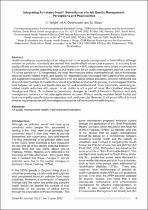 ResearchSpace
ResearchSpace
Integrating air-related health surveillance into air quality management: perceptions and practicalities
JavaScript is disabled for your browser. Some features of this site may not work without it.
- ResearchSpace
- →
- Research Publications/Outputs
- →
- Journal Articles
- →
- View Item
| dc.contributor.author |
Wright, C

|
|
| dc.contributor.author |
Oosthuizen, MA

|
|
| dc.contributor.author |
Steyn, Maronel

|
|
| dc.date.accessioned | 2013-01-29T09:35:14Z | |
| dc.date.available | 2013-01-29T09:35:14Z | |
| dc.date.issued | 2012-06 | |
| dc.identifier.citation | Wright, C, Oosthuizen, MA and Steyn, M. 2012. Integrating air-related health surveillance into air quality management: perceptions and practicalities. Clean Air Journal, vol. 21(1), pp. 3-10 | en_US |
| dc.identifier.issn | 1017-1703 | |
| dc.identifier.uri | http://hdl.handle.net/10204/6487 | |
| dc.description | Published by NACA, hosted by Sabinet Online | en_US |
| dc.description.abstract | Health surveillance is presently not an integral part of air quality management in South Africa, although ambient air pollution standards are derived from health effects of personal exposure. In a survey to air quality officials and environmental health practitioners, respondents were asked to comment on a discussion document regarding ways to put health onto the air quality management agenda. Less than 7% of the sample responded; the most likely reasons being: overloaded staff, lack of knowledge about air quality-related health, and apathy. All respondents acknowledged their support of the concepts, and one mentioned use of an indicator 'number of complaints of visual air pollution and odour'. In general, it would appear that the links between air quality and health risks are not well understood and, more importantly, assessing air-related health outcomes with respect to air quality is not a part of Local Municipalities' Integrated Development Plans. To motivate for necessary changes in Health Information Systems and data management, evidence of valuable application is required. Without readily available health facility and local municipality-specific data on respiratory and cardiovascular illnesses, it would prove difficult to track whether implemented air pollution mitigation measures will have positive health impacts. | en_US |
| dc.language.iso | en | en_US |
| dc.publisher | NACA | en_US |
| dc.relation.ispartofseries | Workflow;9894 | |
| dc.subject | Air quality | en_US |
| dc.subject | Air quality management | en_US |
| dc.subject | Environmental health | en_US |
| dc.subject | Air pollution | en_US |
| dc.title | Integrating air-related health surveillance into air quality management: perceptions and practicalities | en_US |
| dc.type | Article | en_US |
| dc.identifier.apacitation | Wright, C., Oosthuizen, M., & Steyn, M. (2012). Integrating air-related health surveillance into air quality management: perceptions and practicalities. http://hdl.handle.net/10204/6487 | en_ZA |
| dc.identifier.chicagocitation | Wright, C, MA Oosthuizen, and M Steyn "Integrating air-related health surveillance into air quality management: perceptions and practicalities." (2012) http://hdl.handle.net/10204/6487 | en_ZA |
| dc.identifier.vancouvercitation | Wright C, Oosthuizen M, Steyn M. Integrating air-related health surveillance into air quality management: perceptions and practicalities. 2012; http://hdl.handle.net/10204/6487. | en_ZA |
| dc.identifier.ris | TY - Article AU - Wright, C AU - Oosthuizen, MA AU - Steyn, M AB - Health surveillance is presently not an integral part of air quality management in South Africa, although ambient air pollution standards are derived from health effects of personal exposure. In a survey to air quality officials and environmental health practitioners, respondents were asked to comment on a discussion document regarding ways to put health onto the air quality management agenda. Less than 7% of the sample responded; the most likely reasons being: overloaded staff, lack of knowledge about air quality-related health, and apathy. All respondents acknowledged their support of the concepts, and one mentioned use of an indicator 'number of complaints of visual air pollution and odour'. In general, it would appear that the links between air quality and health risks are not well understood and, more importantly, assessing air-related health outcomes with respect to air quality is not a part of Local Municipalities' Integrated Development Plans. To motivate for necessary changes in Health Information Systems and data management, evidence of valuable application is required. Without readily available health facility and local municipality-specific data on respiratory and cardiovascular illnesses, it would prove difficult to track whether implemented air pollution mitigation measures will have positive health impacts. DA - 2012-06 DB - ResearchSpace DP - CSIR KW - Air quality KW - Air quality management KW - Environmental health KW - Air pollution LK - https://researchspace.csir.co.za PY - 2012 SM - 1017-1703 T1 - Integrating air-related health surveillance into air quality management: perceptions and practicalities TI - Integrating air-related health surveillance into air quality management: perceptions and practicalities UR - http://hdl.handle.net/10204/6487 ER - | en_ZA |





